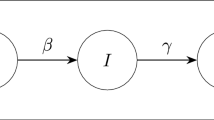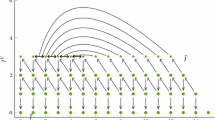Abstract
This paper presents a method for estimating likelihood ratios for stochastic compartment models when only times of removals from a population are observed. The technique operates by embedding the models in a composite model parameterised by an integer k which identifies a switching time when dynamics change from one model to the other. Likelihood ratios can then be estimated from the posterior density of k using Markov chain methods. The techniques are illustrated by a simulation study involving an immigration-death model and validated using analytic results derived for this case. They are also applied to compare the fit of stochastic epidemic models to historical data on a smallpox epidemic. In addition to estimating likelihood ratios, the method can be used for direct estimation of likelihoods by selecting one of the models in the comparison to have a known likelihood for the observations. Some general properties of the likelihoods typically arising in this scenario, and their implications for inference, are illustrated and discussed.
Similar content being viewed by others
References
Bailey N.T.J. 1975. The Mathematical Theory of Infectious Diseases and its Applications. Griffin, London.
Besag J. and Green P.J. 1993. Spatial statistics and Bayesian computation. Journal of the Royal Statistical Society B 55: 25–37.
Catchpole E.A., Morgan B.J.T., and Freeman S.N. 1998. Estimation in parameter-redundant models. Biometrika 85: 462–468.
Cowles M.K. and Carlin B.P. 1996. Markov chain Monte Carlo convergence diagnostics: A comparative review. Journal of the American Statistical Society 91: 883–904.
De Angelis D., Gilks W.R., and Day N.E. 1998. Bayesian projection of the acquired immune deficiency syndrome epidemic (with discussion). Applied Statistics 47: 449–499.
Draper D. 1995. Assessment and propagation of model uncertainty (with discussion). Journal of the Royal Statistical Society B 57: 45–97.
Edwards A.W.F. 1992. Likelihood. The Johns Hopkins University Press, Baltimore.
Gelman A. and Meng X-L. 1998. Simulating normalizing constants: From importance sampling to bridge sampling to path sampling. Statistical Science 13: 163–185.
Geweke J. 1992. Evaluating the accuracy of sampling-based approaches to the calculation of posterior moments. In: Bayesian Statistics 4 (Bernardo J.M., Berger J., Dawid A.P., and Smith A.F.M. (Eds.)) Oxford University Press, Oxford, pp. 169–193.
Gibson G.J. and Renshaw E. 1998. Estimating parameters in stochastic compartmental models. IMA Journal of Mathematics Applied in Medicine and Biology 15: 19–40.
Green P.J. 1995. Reversible-jump Markov chain Monte Carlo computation. Biometrika 82: 711–732.
Jakeman E., Phayre S., and Renshaw E. 1995. The evolution and measurement of a population of pairs. Journal of Applied Probability 32: 1048–1062.
Kadane J.B. and Wolfson L.J. 1998. Experiences in elicitation. The Statistician 47: 3–20.
Metropolis M., Rosenbluth A.W., Rosenbluth M.N., Teller A.H., and Teller E. 1953. Equations of state calculation by fast computing machines. Journal of Chemical Physics 21: 1087–1093.
O'Hagan A. 1998. Eliciting expert beliefs in substantial practical applications. The Statistician 47: 21–36.
O'Neill P.D. and Roberts G.O. 1999. Bayesian inference for partially observed stochastic epidemics. Journal of the Royal Statistical Society A 162: 121–129.
Renshaw E. and Gibson G.J. 1998. Can Markov chain Monte Carlo be usefully applied to stochastic processes with hidden birth times? Inverse Problems 14: 1581–1606.
Richardson S. and Green P.J. 1997. On Bayesian analysis of mixtures with an unknown number of components (with discussion). Journal of the Royal Statistical Society B 59: 731–792.
Ripley B.D. 1987. Stochastic Simulation. Wiley, New York.
Smith A.F.M. and Roberts G.O. 1993. Bayesian computation via the Gibbs sampler and related Markov chain Monte Carlo methods. Journal of the Royal Statistical Society B 55: 2–23.
Tierney L. 1994. Markov chains for exploring posterior distributions. Annals of Statistics 22: 1701–1762.
Author information
Authors and Affiliations
Rights and permissions
About this article
Cite this article
Gibson, G.J., Renshaw, E. Likelihood estimation for stochastic compartmental models using Markov chain methods. Statistics and Computing 11, 347–358 (2001). https://doi.org/10.1023/A:1011973120681
Issue Date:
DOI: https://doi.org/10.1023/A:1011973120681




